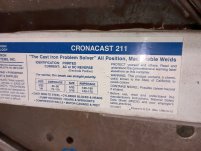Froneck
Titanium
- Joined
- Dec 4, 2010
- Location
- McClure, PA 17059
I have a set-true type lathe chuck that the adjustment tabs are worn so that no adjustment can be made. Spot in the photo is about 5/16" wide and about 3/4" long. A tapered screw moves the tab to adjust the chuck. Screw simply pushes on the slot. I can braze it but don't want the heat! Material is Cast Iron. I do have a few different cast iron rods but they seem to bubble and leave pin holes. After welding I can turn the well tops flat in the late the chuck fits. I do have Eutetic cold spray torch, also hot spray but was thinking of putting the cold spray material in the hot spray torch. Simply put I want to fill the slot yet not get the plate very hot.



